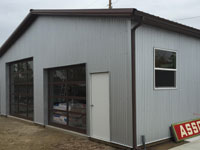Architects, engineers and contractors can select from a plethora of building materials which often incorporate new technology and manufacturing processes. Some of these materials are formulated from substances only barely understood by scientists and chemical engineers.
It was not always so. Life used to be much simpler for engineers and building code officials, back when wood, steel, concrete, brick and other basic building materials were the primary choices for design, and were more easily evaluated for building code compliance.
As the building products industry grew, the number of materials used began to multiply in both number and complexity. Necessity required the establishment of a greater number of broad Acceptance Criteria. The International Code Council Evaluation Service (ICC-ES) uses Acceptance Criteria to evaluate new and innovative products.
Acceptance Criteria started in the 1970s. At the time there were just a handful of criteria. They had been developed by the Research Committee, which was made up of code officials who were members of the International Council of Building Officials (ICBO). This was the forerunner of the current ICC Evaluation Service Committee.
 The ICBO Research Committee not only dealt with a minimal number of Acceptance Criteria, but also developed each individual product evaluation report. These reports were issued by ICBO and used by code officials across the country to help ascertain whether or not a product should be approved as complying with code.
The ICBO Research Committee not only dealt with a minimal number of Acceptance Criteria, but also developed each individual product evaluation report. These reports were issued by ICBO and used by code officials across the country to help ascertain whether or not a product should be approved as complying with code.
In the early 1980s the ICBO Board of Directors decided for the ICBO Research Committee to become the Evaluation Committee. The Evaluation Committee reviewed and established Acceptance Criteria, set policies for the ICBO staff to issue product Evaluation Reports and had final oversight of Evaluation Reports. During the 1980s, new building products exploded in number and became far more technically sophisticated. This growing complexity placed a tremendous burden on the Evaluation Committee members, who met 12 times a year and held open public meetings. Each committee member (often also a full-time building code official) would receive technical data for each product to review for the next meeting. At the same time, the ICBO Board of Directors recognized more time was required to hold open hearings for the growing number of Acceptance Criteria.
To lessen the work burden and allocate enough time for handling Acceptance Criteria, ICBO made a significant change. The Evaluation Committee was tasked with only conducting public meetings on Acceptance Criteria which would establish the guidelines for the ICBO technical staff to research and issue individual product Evaluation Reports.
ICC-ES’s Acceptance Criteria development process is truly unique. It is the culmination of decades of work by thousands of building code officials, with input from every sector of the building products industry. The very fact several other evaluation organizations have begun to mimic ICC-ES Acceptance Criteria, and often cite data derived from ICC-ES Acceptance
Criteria, is strong evidence of how well-respected is the ICC-ES criteria development process.
Each ICC-ES Acceptance Criteria is a comprehensive document of technical guidelines and testing protocols required to demonstrate a product complies with the performance features of the applicable codes, which are referenced in the Acceptance Criteria. It is intended as a road map of evaluation to enable a manufacturer to obtain an ICC-ES Evaluation Service Report (ESR) for their product.
The ESR, which references the Acceptance Criteria, can then be given to a building official to review in order to make a confident decision the manufacturer’s product may be approved for the purposes intended, or is at least equivalent to what is required by the applicable code.
Today, as a subsidiary of the International Code Council (ICC), ICC Evaluation Service has issued more than 400 Acceptance Criteria covering virtually every aspect of the building material industry.
.The ICC-ES staff includes over 30 in-house engineers, product evaluation specialists and technical experts backed by skilled administrative personnel. Many have worked at testing labs and in building departments and are people with firsthand experience. They are an elite group specialized in code and engineering-related issues.
ICC-ES also partners with building industry associations and organizations, to help create a level playing field for all the manufacturers. ICC-ES interprets the standards and codes, with input from the associations and manufacturers.
From an applicant’s perspective, it’s a lengthy process because ICC-ES goes into detail to ensure all required tests are performed by accredited testing labs which have the capability to conduct the specific tests needed. In the end, they deliver Evaluation Reports which are not only authoritative, but a critical tool for code officials. Even though a professional engineer or some other evaluation organization can produce an Evaluation Report, they just don’t have the process, experience and specialized skills to perform the comprehensive evaluations ICC-ES can do.
Today, the ICC-ES Evaluation Committee is composed of 10 building code officials from across the nation. This body holds formal meetings three times a year that are open to the public – to anyone interested in establishing new Acceptance Criteria or modifying existing ones.
.Without question, the American building code community has evolved to a high level of professionalism, and can be trusted implicitly to verify American buildings meet strict requirements for durability and safety. ICC-ES Acceptance Criteria have been, and continue to be, a critical element in providing authoritative guidance to code officials.







How can I find the ICBO report 2440 and what is its equivalent in the ICC codes.
Contact the manufacturer of the product and ask them for it.